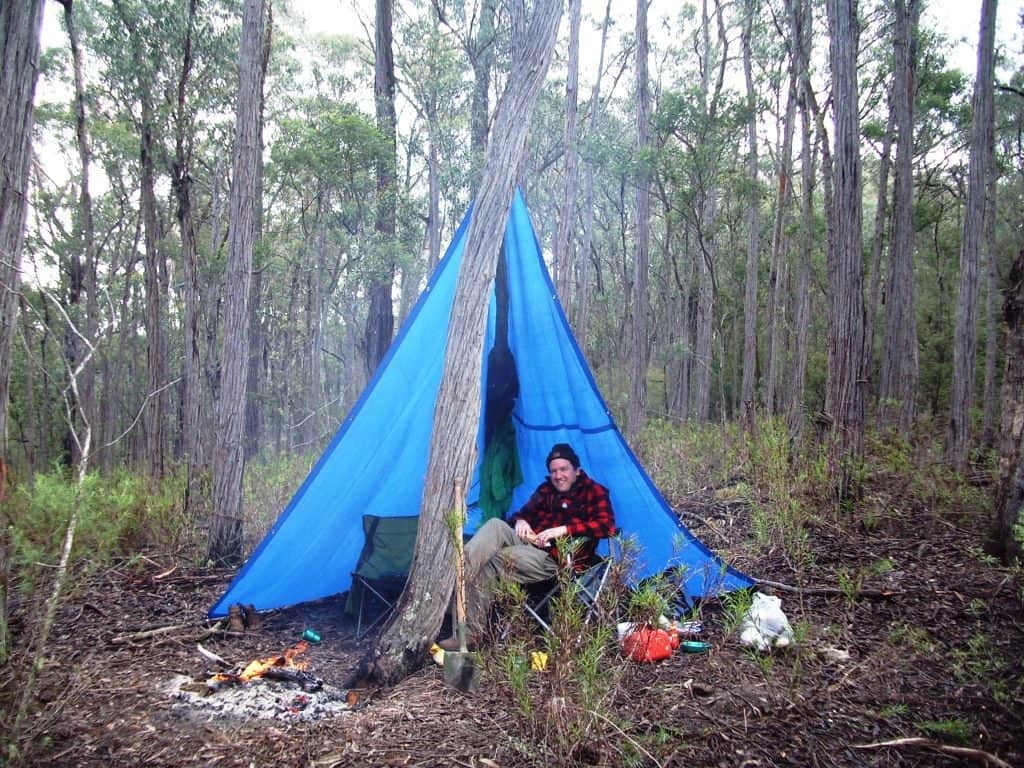Having spent more than fifty years working outside in the rain I was delighted to see this take on the subject. It reminds me a bit of the old adage, ‘When it don’t rain the roof don’t leak; when it do (you) can’t fix it nohow!’
Most times I love being outdoors in the rain. Having been a farmer most of my life, rain generally means good things to me: it means for example the grass will grow and so will the lambs. Having survived a number of quite distressing droughts I know what I would prefer. The sight of ewes and lambs up to their bellies in lush green clover never fails to warm my heart.
It also means the rivers will fill with cool clear water. I also love canoeing, eg: http://www.theultralighthiker.com/pack-rafting-the-remote-wonnangatta/
I love the sound of the rain on a corrugated iron roof such as we have in our owner built house – ie we made every brick, sawed every piece of timber, drove every nail…just as I love hearing it spattering (or thundering down) on my raincoat or poncho hood. I love to gaze out my window at our valley drenched in the morning’s light. Our small world where we have been self-sufficient these many years
I love tramping through the sodden bush peering out at the rain as it slopes down, delighting in the small encapsulated space beneath the peak of my cap.
How many thousands of days’ off I spent hunting deer in the mountain forests of Gippsland in cold winter rain I cannot enumerate. The squelch of the wet road on the tyres and the steady beat of the wipers barely able to keep up. Valleys below drowned in cloud. As the sun breaks above the heavy cloud screen, the mist rises and swirls up the valleys chasing around the mountain tops. A quick cuppa and a biscuit in the shelter of the canopy as the rain drums down on the car’s roof, and then off. The hunt begins.
Here is the mist rising up the Seaforth Valley upstream of Lock Maree, Fiordland New Zealand one such morning in 2006. There had been a rare lone moose out there on those Dashwood flats sometime overnight! I found its tracks. See Lure of the Moose

I have often pushed all day through sodden bush which no rainwear will protect you from, drenched to the skin trying to keep up with the hounds or get in at the final ‘bail-up’, the omnipresence of damp making the forest preternaturally quiet save for the sounds of water running everywhere, lending an advantage to the hunter compared with the constant crunch and crackle of footfall on a sunny day.
I love the sound of rain drumming on the roof of the forest, the rills and runnels pouring down the trunks and washing a foam of saponins as it roils, the swollen drops shaking from branches overhead, as you look up the dimmed light glistening through a million suspended raindrops on the canopy overhead. Heavy wading up a swollen stream hearkening to the faint roar of a hound further up the gully its sound all but drowned by the morning deluge.
I can recall such a scene as this in my mind’s eye. A great stag brought to bay up to his chest against a rocky drop in the gully, the mist swirling about his antlers, my ancient bloodhound, Belle raising her head to the sky and booming at him as if her heart would break, the stag scything a swirl of water off his antlers, his back arched, tail up, a sodden splash as his mighty foot strikes the ground in warning…
I often used to hunt by myself with a couple of hounds back in the 80s and 90s…why, there are Poono and her mother, Belle (and a much younger me) with just such a stag still. This one I stopped, jumping down from the bank (right) injudicious enough to be crossing a woodland track I was hurrying along – a sunny day though by the look of it!
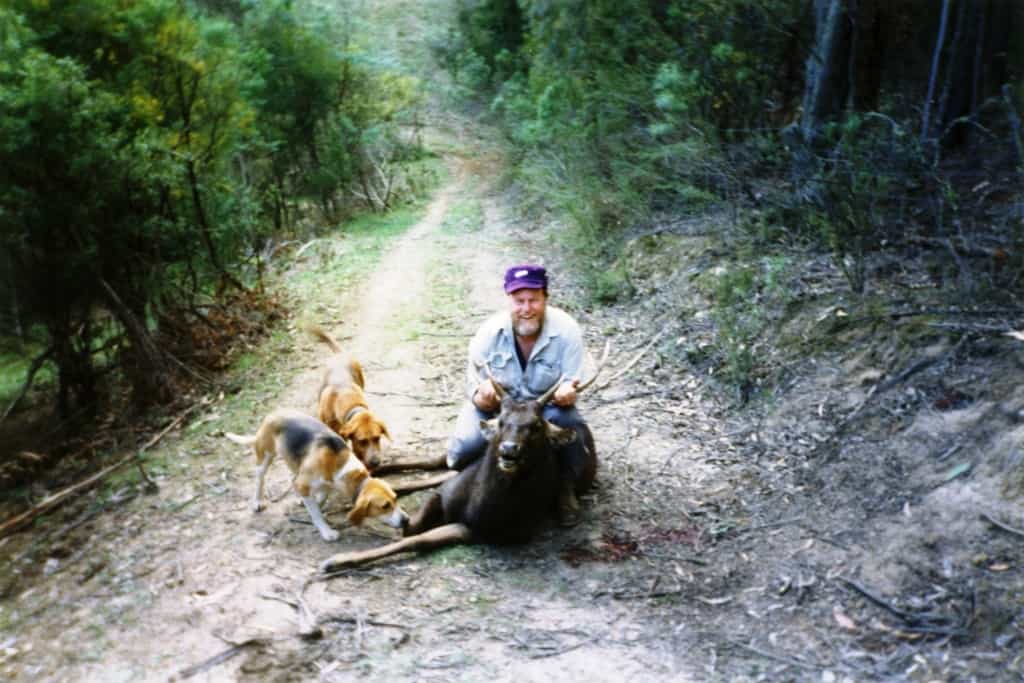
During a wet day I sometimes made a hot cuppa deep in the bush to warm the cockles of my heart (and my hands) while listening to the dogs’ voices waking the distant gullies. A 20 Gram Roll Up Hobo Stove or esbit stove and a metal cup are all you need. After you have had a hot soup or chocolate for example, you will feel much better.
If you look there is always a fallen log to shelter under, a hollow tree or just the lee of a large tree or rock face. The much rubbed wild cherry makes for a good dry space for a pause on a misty morn. Sometimes you have to chase a sheltering deer out from under it!
Of course it is peaceful too at the end of the day to get back to a dry tarp propped against a tree, a cheery fire, a dry change of clothes and a warm (or cold) drink! A long yarn around the fire as the daylight dims and the embers hiss and glow. Maybe the sizzle of a fragrant sausage with onions in the pan.
Something like this perhaps taken many years ago (with Brett Irving). He still has a smile on his face as you can see – after a wet day in the bush, and even though it is still raining. I remember him saying he wished he could stay the night under the tarp – he used often to have to go home (‘work’ is such a nasty word on such occasions) while I waited in solitary splendor for late hounds to straggle in.
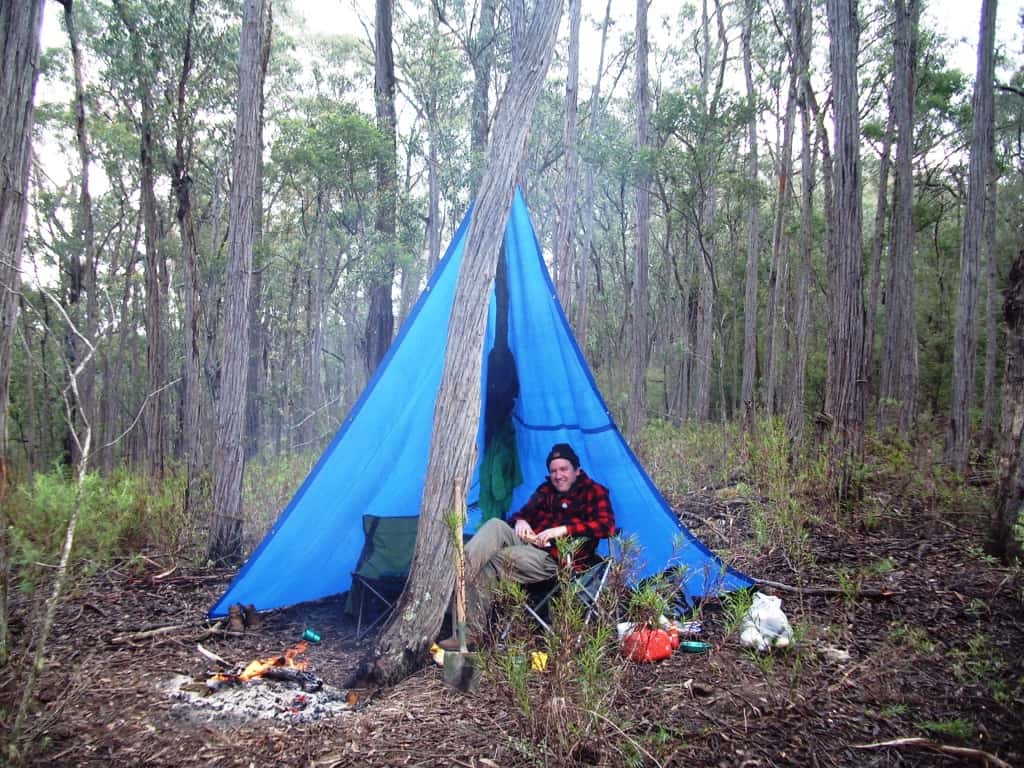
The 10’ x10 ‘ (3 x 3 metres) poly tarp kept us dry and comfy yarning round the fire on many a night waiting for late hounds to return from the hunt. And many’s the night I slept under it. It kept me dry in all sorts of weather, cost less than $10, was used innumerable times and still has a place in my garage against future need. I also made a number of poly tipis over the years which will form the basis of a future post – great for camping in the snow as well – if you know how to have a fire inside!
Of course it is important you don’t get cold. As I have pointed out before, water can strip heat from your body 20 times faster than air. You need to know that and to take action if necessary – as hypothermia is no joke. I have encountered and treated folks who were suffering from it a number of times. Wear clothes which will keep you warm when wet. Stay warm. Dry is not so important.
Our solution as deer hunters was always to wear wool (as you can see Brett doing, and me below). We used to wear the old ex-army khaki woolen trousers with a multiple layers of wool on our upper body usually topped off with a Swandri bush shirt (as seen), and of course wool socks and beanie. This is anything but ‘ultralight’ but it is ‘ultrasafe’ and ‘ultracomfy’ which is more important in the scheme of things.
Here is that woolen clothing in action back in 1990:

There are too many folks who become obsessed with ‘gram counting’ to the extent of jeopardizing both of the latter – which is just silly, and dangerous. There are other materials than wool on the market these days and I have tried them all. In my opinion though none is better than wool. Certainly none which will keep you both warm and sweet smelling! Of course I have spent many years sheep farming, so I may have some bias in this.
It is one thing if you are a track hiker with (maybe) the ‘certainty’ (you hope) of a dry shelter at trail’s end – how many times does that go awry though, with dire consequences? You should never be out in the bush without (the ability to make or find) some dry shelter. Or the ability to light a fire (and keep it going) in the wet. I have encountered people suffering, even dead in the bush who failed of just such basic skills. Don’t let it be you. Read Secrets of Shelter
A shelter may just be an umbrella, or even sheltering under your raincoat, but really it should include a poncho/tarp (so you can lie down) which can be as light as approx 150 grams (eg for an 8’ x 8’ cuben square) or at very least the knowledge and ability to find and construct a shelter with natural materials – and the tools to do so (See Hatchet and Debris Hut). The minimum to take with you even on a day hike is a mylar space blanket (or three) which you can pitch like this if you have a few bits of string, and maybe some of these from your fishing kit, or eg one of these fancy emergency shelters.
There is nothing at all wrong with a cheap 5′ x 7′ (150 x 210 mm) nylon poncho – though a bit longer (8′ or more) is even better. I used one as a raincoat for many years, and I have slept under it in the rain numerous times. It might be minimal, but it is enough, if you are careful – and it is infinitely better than being wet and cold. Mine cost me under A$20 over thirty years ago but it has done good service. I see they are now more like A$80 but worth every penny. I notice Aricxi still have them for <$40 on Aliexpress. A poncho will keep you drier on those extremely humid days than any raincoat, as they admit more air flow.
You never know when you will lose the trail (or your way), or the trip cannot be completed due to flooded rivers, a twisted ankle, a companion suddenly staggering with hypothermia, etc. The old Boy Scout’s motto of ‘Be Prepared’ is ever a good one, though I was never a scout myself, as I grew up in the trackless bush far from any town. Baden Powell though, the hero of Mafeking was not a sissy!
Just as an example, here are Della and I out in the very wet bush of the South Coast Track Fiordland New Zealand in 2016, and loving it! I should point out that our combined age on that trip was 135+, and we are still going strong (now 147!) Della is a bit less fond of wet and cold than I am as she has more trouble staying warm (more layers needed). That adipose comes in handy betimes!
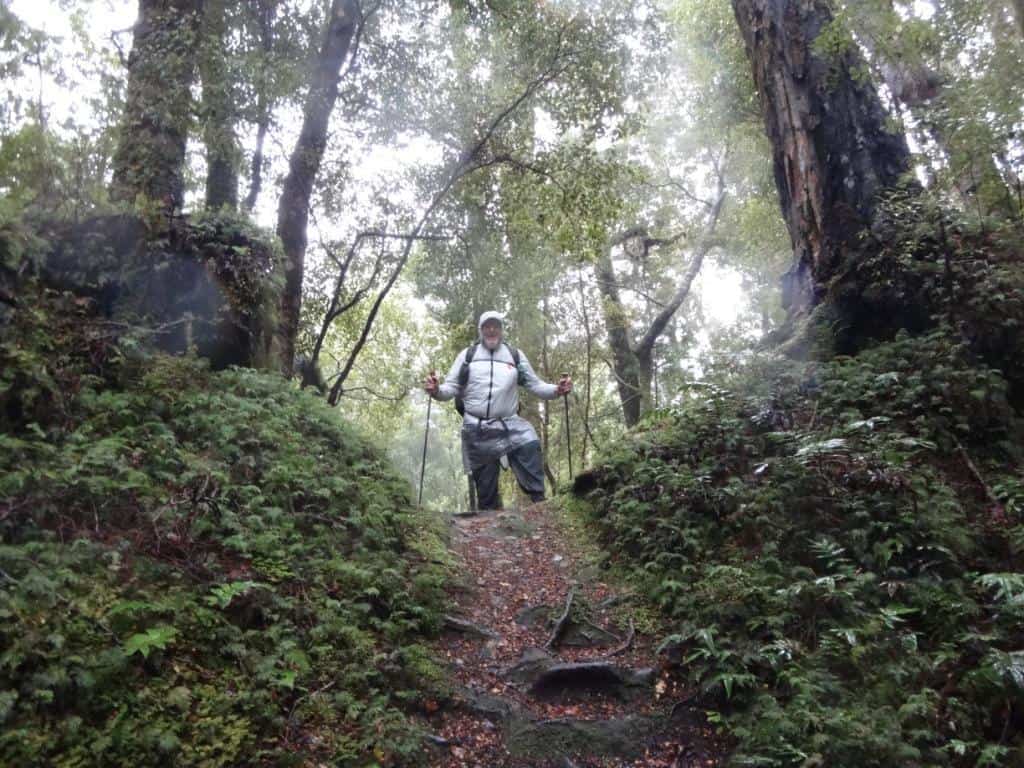
The burns were in flood
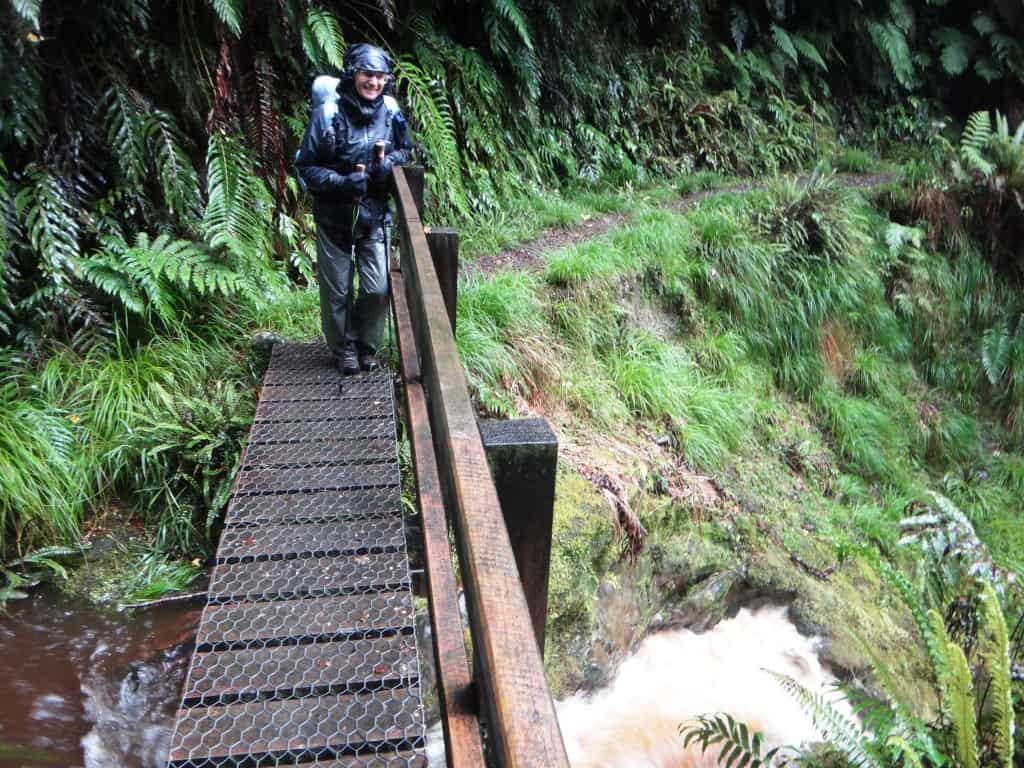
And it was wet enough even to ‘drown’ a waterproof camera.
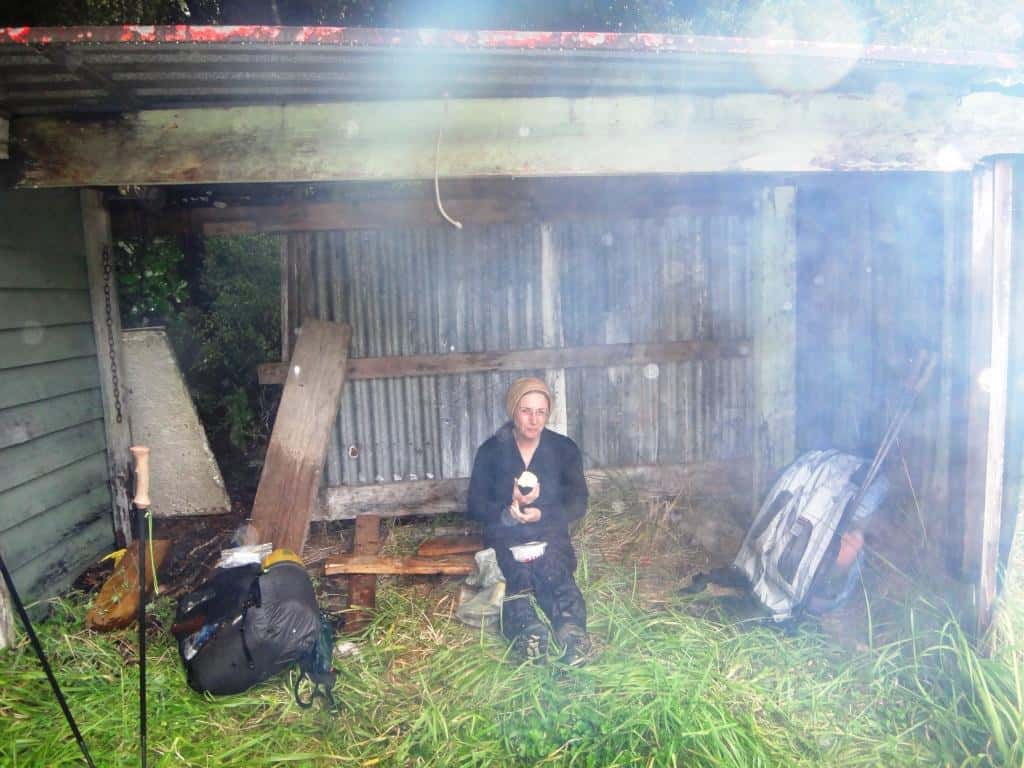
An aside about waterproof shoes: This is a really silly if not dangerous idea. Don’t buy them for the bush. If you are walking most anywhere in the wilds before long you are going to come to a stream or at least a deep pool which you have to cross. You are going to have to walk right through it. Unless your shoes come right up to your eyeballs you are going to get wet feet. They will dry out. You are not soluble. if you are wearing wool socks your feet will not stay cold because they are wet.
Also, don’t spend time trying to creep around the obstacle without getting your feet wet, or cross on a log or leap from stone to stone. You are just going to hurt yourself or end up drowned because you are in over your head unexpectedly in some pretty bad water! Best to just step right in as soon as you come to the waterway.
In no circumstances should you ever take your shoes off and walk across barefoot. A seriously cut foot miles from anywhere is a disaster! You may carry a pair of shoes for river crossings I suppose, but I find a pair of camp shoes better value. I make my own out of Dyneema, 13 grams each. See Sub One Ounce Per Pair Camp Shoes
In any case waterproof shoes are almost certainly going to be heavier when wet and stay heavier longer. Don’t buy them. These Topos at 290 grams are quite good though.
All of the above is a ‘by-the-bye’ really. I hope you take a look at these folks’ excellent website though. It certainly reminded me (if I needed it) that walking is for fun, and was replete with excellent advice, which I admit I have not had time to properly absorb – having spent nearly two weeks working on Tiny’s eulogy (below):
PS: I have Jenn’s kind permission to re-post her ideas here.
First Published: Feb 23, 2018
See also these posts:
and these mentioned in main article:
http://www.theultralighthiker.com/multiple-use/
http://www.theultralighthiker.com/why-you-should-get-your-feet-wet-when-hiking/
http://www.theultralighthiker.com/the-importance-of-a-roof/
http://www.theultralighthiker.com/from-dawn-to-dusky-4/
http://www.theultralighthiker.com/the-egg-ring-ultralight-wood-burner-stove/
http://www.theultralighthiker.com/ultralight-esbit-stove/
http://www.theultralighthiker.com/ultralight-cookpot/
http://www.theultralighthiker.com/how-to-light-a-fire-in-the-wet/
http://www.theultralighthiker.com/fire-on-the-snow/
http://www.theultralighthiker.com/hiking-in-the-rain/
http://www.theultralighthiker.com/raincoat-shelter/
http://www.theultralighthiker.com/the-pocket-poncho-tent/
http://www.theultralighthiker.com/pitching-the-poncho-warning-this-may-save-your-life/
http://www.theultralighthiker.com/worlds-lightest-tarp-clip/
http://www.theultralighthiker.com/the-ultralight-fisherman/
http://www.theultralighthiker.com/new-ultralight-survival-shelter/
http://www.theultralighthiker.com/a-walk-in-fiordland/
http://www.theultralighthiker.com/pack-rafting-the-remote-wonnangatta/
http://www.theultralighthiker.com/topo-terraventure-shoes/
http://www.theultralighthiker.com/a-tiny-life/

